
The objective of this puzzle is to move the discs, one at a time, from start to finish.
You are not allowed to put a disc on top of a smaller disc.
You will be awarded a trophy if you can complete the puzzle in the minimum number of moves.

Start by moving this disk.



The objective of this puzzle is to move the discs, one at a time, from start to finish but you are not allowed to put a disc on top of a smaller disc.
You will be awarded a trophy if you can complete the puzzle in the minimum number of moves.
Investigation
Complete the first five levels of this puzzle and keep your results in a table. Can you work out how the minimum number of moves is related to the number of discs? Could you fill in the rest of the table without doing levels 6 to 10 of the puzzle?
| Number of discs |
1 |
2 |
3 |
4 |
5 |
6 |
7 |
8 |
9 |
10 |
| Minimum Moves |
1 |
|
|
|
|
|
|
|
|
|
The solutions to this and other Transum puzzles, exercises and activities are available in this space when you are signed in to your Transum subscription account. If you do not yet have an account and you are a teacher or parent you can apply for one here.
A Transum subscription also gives you access to the 'Class Admin' student management system and opens up ad-free access to the Transum website for you and your pupils.
Suggested
Without Lifting The Pencil
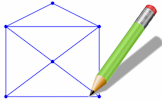 Can you draw these diagrams without lifting your pencil from the paper? This is an interactive version of the old puzzle.
The short web address is:
www.transum.org/go/?to=without
|
Suggested
River Crossing
 Threee traditional River Crossing challenges. Can you do them in the minimum number of moves?
The short web address is:
www.transum.org/go/?to=river
|
Suggested
Pu Wiang
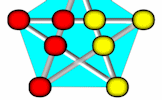 Switch the positions of the red and yellow counters for this challenge invented in northern Thailand.
The short web address is:
www.transum.org/go/?to=puwiang
|
The Tower of Hanoi (also called the Tower of Brahma or Lucas' Tower) was invented by the French mathematician Édouard Lucas in 1883.
There is a story about an Indian temple which contains a large room with three old posts and 64 golden disks. Brahmin priests, acting out the command of an ancient prophecy, have been moving these disks for countless years. According to the legend, when the last move of the puzzle will be completed, the world will end!
Level 10 of this puzzle featured in an episodeIn the 1966 Doctor Who story called The Celestial Toymaker. The villain forces the Doctor to work on a ten-piece Tower of Hanoi puzzle (which they call The Trilogic Game) and if the Doctor manages to complete the puzzle, the Toymaker's domain will disappear.
Suggested
Squorder
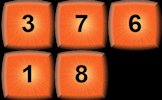 The Transum version of the traditional sliding tile puzzle. Arrange the numbers 1 - 8 in the minimum number of moves.
The short web address is:
www.transum.org/go/?to=squorder
|
Suggested
Scheduling Puzzle
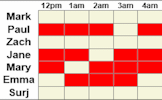 Make a schedule for the 24-hour Darts Marathon while taking into account all of the restrictions.
The short web address is:
www.transum.org/go/?to=scheduling
|
Suggested
Shunting Puzzles
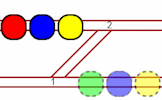 Move the trams to their indicated parking places in the shunting yard as quickly as possible.
The short web address is:
www.transum.org/go/?to=shunting
|
The solutions to this and other Transum puzzles, exercises and activities are available here when you are signed in to your Transum subscription account. If you do not yet have an account and you are a teacher, tutor or parent you can apply for one by completing the form on the Sign Up page.
A Transum subscription also gives you access to the 'Class Admin' student management system, downloadable worksheets, many more teaching resources and opens up ad-free access to the Transum website for you and your pupils.
Subscriber Ann has been doing some deep thinking about this activity.
I will let Ann continue:
"What’s the biggest problem when you’re playing the Tower of Hanoi? You lose concentration or get interrupted and can’t remember the direction of play.
Have you ever noticed that some pieces move more often than others? The smallest piece is constantly on the move. What about the largest piece? Have you noticed that it only makes one move in the entire game? It’s either on START or FINISH.
This is a game of two parts. In the first part, we’re trying to demolish the stack on START to free the largest piece. In the second part, the largest piece is now on FINISH and we are trying to build a stack above it.
When the monk goes to the Temple, the first thing he will ask himself is ‘Where is the largest piece?’
What does the monk ask himself next?
Ages ago, you asked me if there was an algorithm. I suppose there is. The monk only needs to ask himself five questions at most to know the next move.
It’s surprisingly easier to do than expected. I’m not great at the Tower of Hanoi, I lose concentration easily but I can do the Temple Challenge. Would you like to know the monks secret? It’s here."
Ann would love to hear if you have any comments after reading her instructions. She would also be very interested to know if the Tower of Hanoi actually exists. Has anyone seen it? Would anyone have photos? The temple is a religious place so it’s possible that there are no photos. On the other hand, there may be no photos because it’s only a myth.

Which piece should you move next? Can you tell just by looking?





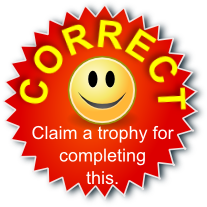











The Math Book,
Sunday, August 11, 2019
"Simple algorithms exist for solutions involving three pegs, and the game is often used in computer programming classes to teach recursive algorithms. However, the optimal solution for the Tower of Hanoi problem with four or more pegs is still unknown!"
Bridget Lindley, UK
Saturday, October 31, 2020
"I have a plastic Tower of Hanoi from 1950s with 8 discs, but with only two colours (yellow and blue). Much easier to keep track of your moves than with lots of colours especially when so close in size."
Ella, Home Schooling
Tuesday, January 26, 2021
"This is quite hard but really fun and I have the whole family involved (even the cat). I always enjoy completing Transum tasks and can't wait to see more like this!"
Bernie Westacott, Twitter
Friday, February 19, 2021
Khethelo, South Africa
Thursday, July 18, 2024
"This surely had me fry my brain .However, it was lots of fun.My Mom and I got it right:)."